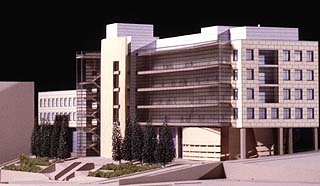
Skanska
Specialty: General contracting, construction management and design-build services in the commercial office, health care, and science and technology market sectors
Washington Division principals: President Bob Babitsky, Executive Vice President John Hayduck, Senior Vice President Curt Kraft and Vice Presidents Scott Lee and Kyle Roquet
Year founded: 1946
Local office: Seattle
Largest project in 2002: Marion Oliver McCaw Hall

Courtesy LMN Architects Skanska is the general contractor for a new $15.7 million government center in Bremerton. |
Earlier this year, Skanska wrapped up several years of branding transition. The large commercial contractor merged operations with Baugh in 2000 and last year became Baugh Skanska. In the first quarter of 2003, all of the organizations in the Skanska network were renamed simply Skanska.
“We are exactly the same people, just under a new name,” said Tony Stewart, director of business development for the Washington Division of Skanska.
Working as a single brand nationally “strengthens our ability to serve clients,” he added, explaining that the Washington Division can work with other divisions whose expertise may be different.
Skanska’s Washington Division built on this national platform, for instance, to land a contract to build a laboratory for the National Institute of Health in Hamilton, Mont.
With the commercial office market lagging, Stewart said it’s important for the company to branch out using its stature as a multi-facted national firm. The Washington Division of Skanska is expanding its focus to do more work in the health care, science and technology, and government sectors.
“The Skanska name and branding allows us to grow geographically throughout the Western region of the United States,” Stewart said. “We’re looking to grow our operations in California, particularly in health care.”
Also boosting Skanska in Washington is the Legislature’s decision several years ago to allow some public projects to use the general contractor/construction manager, or GC/CM, format.
Under GC/CM, project owners evaluate contractors not merely on the amount of their bid but also on their experience, reliability and proposed team and approach to a project. This is opposed to the typical lump-sum format where contractors are selected based mostly on low bids.
The King County Courthouse retrofit started as a qualified lump-sum project but was switched to an emergency negotiated contract using the GC/CM format, and Skanska won that contract.
GC/CM “has allowed us to enter into markets that we normally wouldn’t enter into,” Stewart said.
Overall, Skanska officials are optimistic. At the end of 2002, according to Stewart, Skanska was able to hold its revenue stream relatively the same as in 2001. “We feel good we were able to do that.”
Even though the economy has not yet taken off again, the company still is holding onto its optimism because of its ability to grow along with other Skanska divisions.
“Our focus is retaining our client base of our long-term relationships first,” Stewart said, “and growing new client relationship and being selective about selecting and retaining the right clients.”